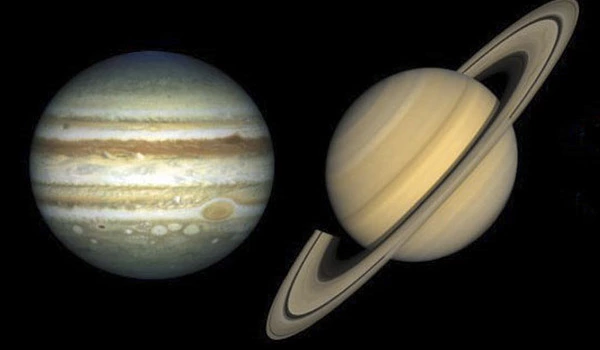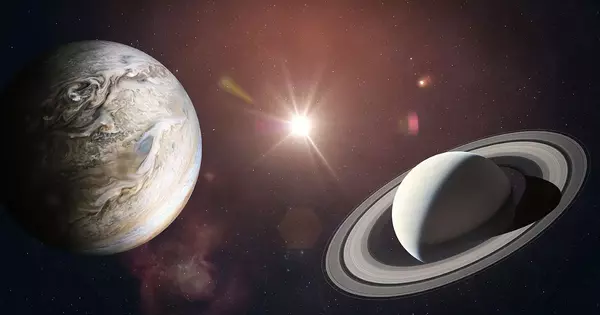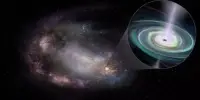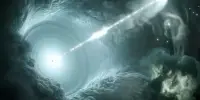Ring systems provide scientists with information about a planet’s history. Rings can be temporary structures that form around planets. Jupiter’s large moons prevent it from having a more spectacular ring system. Jupiter should have larger, more spectacular rings than Saturn because it is larger. However, according to new UC Riverside research, Jupiter’s massive moons prevent that vision from lighting up the night sky.
“It’s always puzzled me why Jupiter doesn’t have even more amazing rings that rival Saturn’s,” said UCR astrophysicist Stephen Kane, who led the study. “If Jupiter had them, they’d be even brighter to us because Jupiter is so much closer to us than Saturn.” Kane also wondered if Jupiter once had fantastic rings and then lost them.
To figure out why Jupiter looks the way it does, Kane and his graduate student Zhexing Li ran a dynamic computer simulation that took into account the orbits of Jupiter’s four main moons, as well as the planet’s own orbit and the time it takes for rings to form. Their findings are now available online and will be published in the journal Planetary Science shortly.
We found that the Galilean moons of Jupiter, one of which is the largest moon in our solar system, would very quickly destroy any large rings that might form. As a result, it is unlikely that Jupiter had large rings at any point in its past. Massive planets form massive moons, which prevents them from having substantial rings.
Stephen Kane
Saturn’s rings are mostly composed of ice, some of which may have originated from comets, which are also mostly composed of ice. If the moons are large enough, their gravity can throw ice out of a planet’s orbit or change the ice’s orbit enough to collide with the moons.
“We found that the Galilean moons of Jupiter, one of which is the largest moon in our solar system, would very quickly destroy any large rings that might form,” Kane said. As a result, it is unlikely that Jupiter had large rings at any point in its past.
“Massive planets form massive moons, which prevents them from having substantial rings,” Kane said.
Ring systems help astronomers understand the history of a planet, as they are evidence of past interactions with comets or moons. The shape of the rings and their compositions offer clues on what these interactions might have been. Kane says, “For us astronomers, they are the blood spatter on the walls of a crime scene. When we look at the rings of giant planets, it’s evidence something catastrophic happened to put that material there.”

Our solar system’s four giant planets, Saturn, Neptune, Uranus, and Jupiter, all have rings. However, the rings of Neptune and Jupiter are so thin that they are difficult to see with traditional stargazing instruments.
Coincidentally, some of the most recent images from the newly commissioned James Webb Space Telescope show Jupiter with its faint rings visible. “We didn’t know these ephemeral rings existed until the Voyager spacecraft passed by,” Kane explained.
Uranus has rings that are smaller in size but more substantial than Saturn’s. Kane plans to run simulations of Uranus’s conditions in the future to determine the lifetime of the planet’s rings. Some astronomers believe Uranus is lying on its side as a result of a collision with another celestial body. Its rings could be the remnants of that collision.
Aside from their beauty, rings help astronomers understand the history of a planet by providing evidence of past collisions with moons or comets. The shape and size of the rings, as well as the material composition, provide information about the type of event that formed them.
“For us astronomers, they are the blood spatter on the walls of a crime scene. When we look at the rings of giant planets, it’s evidence something catastrophic happened to put that material there,” Kane said.
The researchers plan to use their simulations to investigate Uranus’ ring system. This investigation could reveal how long Uranus’ rings will last and why it orbits the sun differently than the other planets in the solar system — the ice giant orbits the sun on its side, which astronomers believe is due to a collision with another body. The remnants of this impact could be Uranus’ ring system.
“They are the blood spatter on the walls of a crime scene for us astronomers,” Kane said. “When we look at the rings of giant planets, we see evidence that something catastrophic happened to deposit that material.”
















